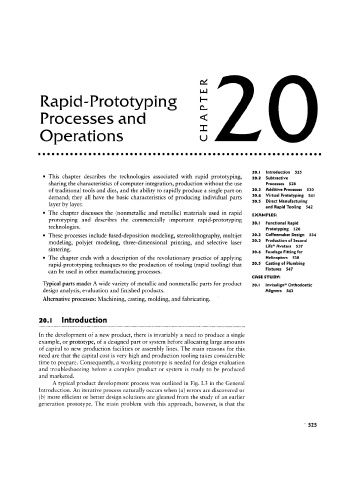Page 545 - 04. Subyek Engineering Materials - Manufacturing, Engineering and Technology SI 6th Edition - Serope Kalpakjian, Stephen Schmid (2009)
P. 545
Rapid-Prototyping
Processes and
Operations
20.l Introduction 525
° This chapter describes the technologies associated with rapid prototyping, 20.2 Subtractive
sharing the characteristics of computer integration, production without the use Processes 528
of traditional tools and dies, and the ability to rapidly produce a single part on 20.3 Additive Processes 530
20.4 Virtual Prototyping 54|
demand; they all have the basic characteristics of producing individual parts
20.5 Direct Manufacturing
layer by layer.
and Rapid Tooling 542
° The chapter discusses the (nonmetallic and metallic) materials used in rapid EXAMPLES:
prototyping and describes the commercially important rapid-prototyping
20.1 Functional Rapid
technologies. Prototyping 526
U These processes include fused-deposition modeling, stereolithography, multijet 20.2 Coffeemaker Design 534
modeling, polyjet modeling, three-dimensional printing, and selective laser 20.3 Production of Second
Life® Avatars 537
sintering.
20.4 Fuselage Fitting for
° The chapter ends with a description of the revolutionary practice of applying Helicopters 538
rapid-prototyping techniques to the production of tooling (rapid tooling) that 20.5 Casting of Plumbing
Fixtures 547
can be used in other manufacturing processes.
CASE STUDY:
Typical parts made: A wide variety of metallic and nonmetallic parts for product 20.l lnvisa|ign® Orthodontic
design analysis, evaluation and finished products. Aligners 543
Alternative processes: Machining, casting, molding, and fabricating.
20.l Introduction
In the development of a new product, there is invariably a need to produce a single
example, or prototype, of a designed part or system before allocating large amounts
of capital to new production facilities or assembly lines. The main reasons for this
need are that the capital cost is very high and production tooling takes considerable
time to prepare. Consequently, a working prototype is needed for design evaluation
and troubleshooting before a complex product or system is ready to be produced
and marketed.
A typical product development process was outlined in Fig. 1.3 in the General
Introduction. An iterative process naturally occurs when (a) errors are discovered or
(b) more efficient or better design solutions are gleaned from the study of an earlier
generation prototype. The main problem with this approach, however, is that the
525
ER A
PT
CH

